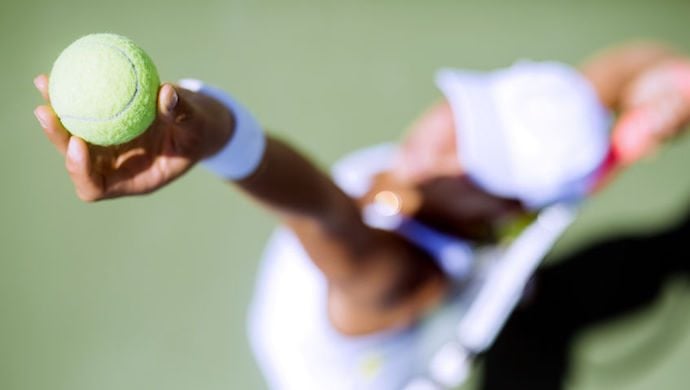Sports have been an inspirational source of business lessons, and we can gain key insights to apply to the workplace

Among all sports, tennis stands apart due to its unique nature, as it combines multiple components including fitness, mental strength, focus, strategy, footwork, and technique. In many ways, this perfectly relates to skills necessary to start and manage a successful business venture.

Here are three lessons we can learn about entrepreneurship, leadership and management from tennis.
1. Fitness
Fitness includes strength, stamina, speed, flexibility, and hand-eye coordination. Tennis requires strength to navigate the court, which is 78 feet long and 27 feet wide (around 23.77 x 8.23 metres) for single matches. Such dimensions require enough stamina to last for long durations, along with speed and flexibility during movements. All these skills combined with good hand-eye coordination lead to good results on the tennis court.
On similar lines, an entrepreneur needs the strength to launch and scale up a business from the scratch. Following ground up approach, ideas are converted into prototypes (MVP), which requires fitness skills similar to those required for tennis, including strength and stamina to be consistent, speed to adapt quickly, and flexibility to test new ideas.
As tennis requires hand-eye coordination, business leadership and management requires control over execution of plans to ensure that there are no deviations.
For example, financial projections of business may look good while writing business plan, but finding first 10 users who would be ready to use a product is crucial to validate the business model.
Also Read: Does PayTM’s logo look similar to PayPal? PayPal thinks YES!
Similarly, to find the perfect product market fit (being in a good market with a product that can satisfy that market), it is a good strategy to ask technical questions from experts and publish white-papers to share new solutions with the potential customers. Based on their response, potential customers can be consulted to validate business model during early stages of the startup.

2. Strokes
The fundamentals of tennis include proper execution of the main strokes, such as, forehand groundstroke, backhand groundstroke, serve, volleys, and the spins. While playing important strokes like forehand and backhand, a relaxed arm with a loose wrist works way better than a stiff posture.
Similarly, successful leaders remain relaxed and calm while managing business to ensure proper execution of plans and to achieve the desired results. In addition, average leaders become good leaders and good leaders become great leaders by managing people smoothly like humans and not abruptly like machines. This is akin to hitting the tennis ball firmly with a comfortable and smooth swing, which is a result of having a relaxed arm.
For example, understanding what motivates the team members beyond compensation helps in leading the team in right direction by driving them towards a mission. Some employees get motivated by personal brand building around values and skills they bring on table, which helps them ensure future marketability. Hence, reducing fears of job security among employees increases productivity and efficiency of the employees.
3. Footwork
Surviving on the tennis court requires maintaining proper balance while executing different types of strokes. While taking up shots, adjustment of few steps helps greatly. Not planting your feet too firmly on the ground provides better court movement.
Similarly, while leading a team or growing a business, maintaining a proper balance and staying focused form a key element of entrepreneurship. For example, one way to ensure that an early stage business remains focused in right direction is to perform routine audits regarding technicality, revenue model, marketing strategy, etc.
This can be done by working backwards, i.e. by first mapping down the goals and then reverse engineering from there to determine what all steps are required to be executed to achieve such goals. While performing such analysis, if it is revealed that the business is not on right track, the required changes can be made by staying balanced and not making decisions in haste.
Also Read: Planning your product strategy? Make sure your infrastructure can take on the load
When feet are planted firmly in ground, it is difficult to be flexible and adjust few steps (pivot) before taking any decision. Therefore, having an adaptable approach during various stages of business can boost the success ratio and provide highly beneficial results to individual entrepreneurs and business leaders.
Conclusion
Sports have been an inspirational source of business lessons, and we can gain key insights to apply to the workplace. Learning such valuable lessons generally acts as the catalyst to help business owners stay ahead of the pack and scale the business to greater heights.
Hope you found this useful. I would be sharing more such experiences in coming weeks. Thank you.
—-
Rahul Dev is a Patent Attorney & International Business Lawyer practicing Technology, Intellectual Property & Corporate Laws. He is reachable at info (at) techcorplegal (dot) com & @rdpatentlawyer on Twitter
Originally published here.
Also read: Journey of my blog from LinkedIn to 30+ news portals
The views expressed here are of the author’s, and e27 may not necessarily subscribe to them. e27 invites members from Asia’s tech industry and startup community to share their honest opinions and expert knowledge with our readers. If you are interested in sharing your point of view, submit your post here.
Featured Image Copyright: nd3000 / 123RF Stock Photo
The post Match point: What tennis can teach us about entrepreneurship and leadership appeared first on e27.